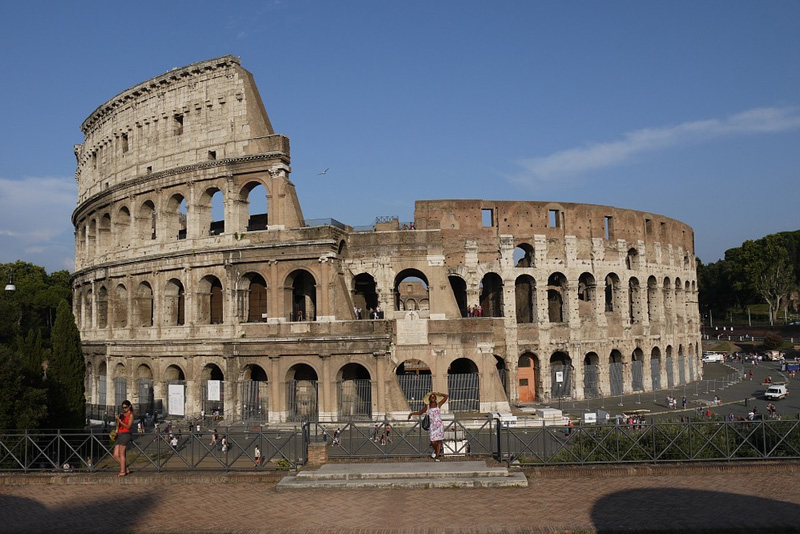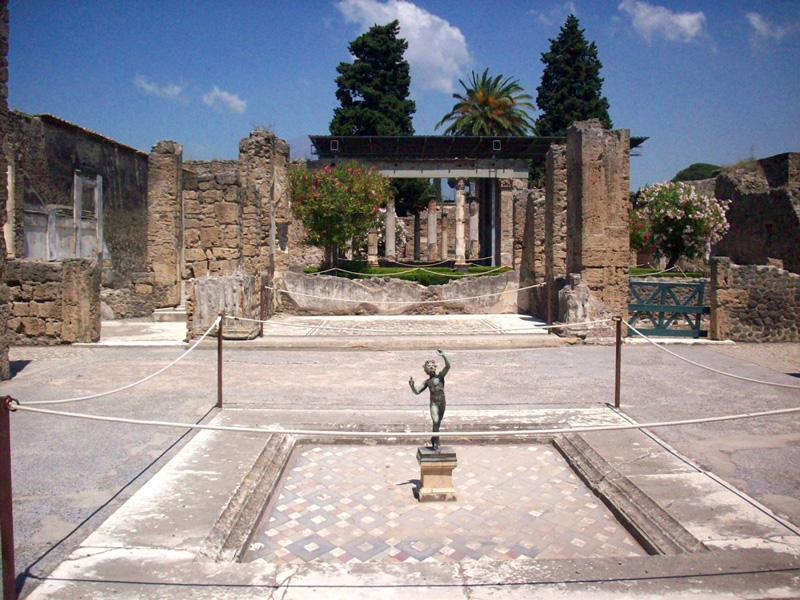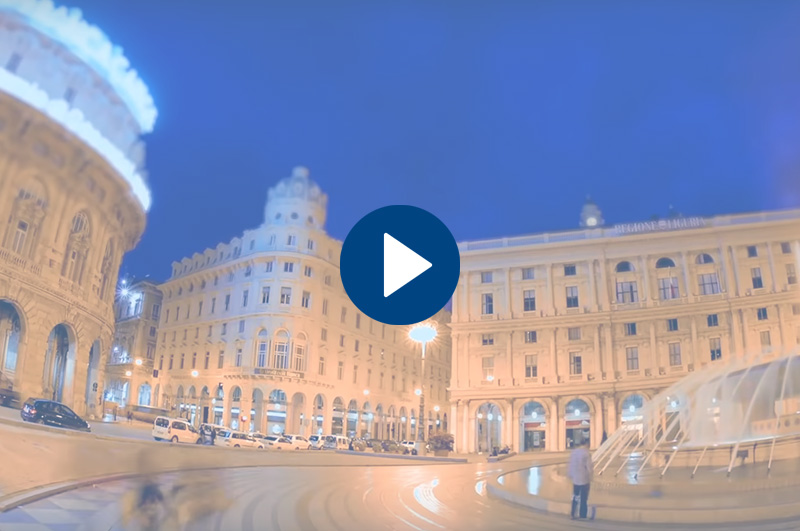5-day BERNINI PRIVATE TOUR
Rome, Pompei, the Amalfi Coast and Naples
WHAT'S INCLUDED:
Accommodations in Double Room with Continental Breakfast (*):
- Day 1: 3* to 5* Hotel in Rome city centre
- Day 2: 3* to 5* Hotel in Castelli Romani area
- Days 3 & 4: 3* to 5* Hotel on the Amalfi Coast
- Day 5: 3* to 5* Hotel in Naples city centre
(*) The Hotel List is available upon request
Transfers (**):
- Day 2: Transfer from your accommodation to the entrance of the Vatican Museums and back - Transfer to your accommodation in the Castelli Romani area
- Day 3: Transfer to your accommodation on the Amalfi Coast – Stopover in Pompei
- Day 5: Transfer to your accommodation in Naples
(**)All transfers by private car (2 pax)/ minivan (3 to 6 pax)/ minibus (7 to 10 pax)
Private Guided Visits / Tours (***) / Activities:
- Day 1: 3-hour private walking tour of Imperial Rome with an Authorised Tourist Guide
- Day 2: 3-hour private walking tour of the Vatican City with an Authorised Tourist Guide - Visit of a Frascati wine cellar with tastings
- Day 3: 2-hour private guided visit of Pompei Archeological Area with an Authorised Tourist Guide
- Day 4: Full-day excursion of the Amalfi Coast: Amalfi, Positano and Ravello
- Day 5: Lemon experience with lunch in Amalfi
(***)All tours by private car (2 pax)/ minivan (3 to 6 pax)/ minibus (7 to 10 pax)
Admission Tickets to:
- Colosseum and Imperial Fora in Rome
- Vatican Museums with the Sistine Chapel in Rome
- Pompei Archeological Area
Full emergency assistance 24 hours/day by our Back Office
List of recommended restaurants and deli shops along the itinerary
All taxes
Options:
- Pick up at Rome Airport /Railway Station on the day before the start of the tour
- Accommodation in Rome the night before the start of the tour
- Admissions to the Pantheon and Galleria Borghese in Rome
- Lemon experience with lunch in Amalfi
- Drop off at Naples Airport /Railway Station at the end of the tour
- Other options upon request
DAY 1 – ROME
Benvenuti in Italia, welcome to Rome!
Here you are in Rome, where ancient history, excellent art and religious icons mix uniquely! Start from the 2,000-year-old Colosseum, the most famous amphitheatre in the world, and the Imperial Fora, the administrative and monumental centre of the Roman Empire. On the Palatine Hill, the majestic ruins of the Palaces of Augusto, Tiberius and Domiziano still dominate theCircus Maximus valley, 50-meter-high structures giving a unique view of the city.
Close to the Colosseum, inside the Church of San Pietro in Vincoli, you may see the famous Michelangelo sculpture of “Moses”. Supposedly, Michelangelo, admiring his Moses, enraptured by the so realistic shapes of the imposing statue, was struck by a violent outburst of anger and exclaimed the famous phrase “Perchè non parli?" (Why don't you speak!?)
From Piazza Venezia, you will head inside “Baroque” Rome, starting with the Pantheon, dedicated to worshipping every god (Pan-every Theon-divinity), now the memorial chapel of great Italian people of the past. After that, don’t miss the Church of St. Louis of the French, famous for the cycle of paintings of the great Caravaggio at the end of the 16th century. Then Piazza Navona, the splendid oval area corresponding to the underground Domitianus’ Stadium, with the gorgeous Fountain of the Four Rivers by Lorenzo Bernini in the centre of the Piazza. And finally, Fontana di Trevi, the city’s biggest and most famous fountain, a Rome icon renowned worldwide: here, statues of travertine marble stand over the cliff and the broad basin in an epic representation of the Kingdom of the Oceans.
At the end of the day, sit down at a local "trattoria" or "fiaschetteria", the typical home-style restaurant, to taste authentic Roman cuisine in a popular and cheerful atmosphere (for an overview of Roman cuisine, see our BLOG).

DAY 2 – VATICAN CITY AND CASTELLI ROMANI
On the other side of River Tevere, Vatican Hill is the home of the tiny state of Vatican City. The immense St. Peter’s Basilica dominates the extraordinary Piazza framed by the magnificent four-column-deep colonnades designed by Gian Lorenzo Bernini. The Basilica is an extraordinary casket for some of the world's most beautiful works of art, such as Michelangelo’s “La Pietà” and Bernini’s “Baldacchino”, along with works of the most important artists of the Renaissance, from Raphael to Canova.
Inside the Vatican Museums, you will be astonished by the exquisite and unique Sistine Chapel, the “Sancta Sanctorum” (“Holy among the Holiest” in Latin) of the Roman Catholic Church, where cardinals gather to elect the new Pope! The Sistine Chapel takes its name from Pope Sixtus IV della Rovere (pontiff from 1471 to 1484), who had the old Cappella Magna restored between 1477 and 1480. The decoration of the walls was executed by a team of painters, Pietro Perugino, Sandro Botticelli, Domenico Ghirlandaio and Cosimo Rosselli, assisted by their respective shops.
Julius II della Rovere (pontiff from 1503 to 1513), the nephew of Sixtus IV, decided to partly alter the decoration, entrusting the work in 1508 to Michelangelo Buonarroti, who painted the Ceiling and, on the upper part of the walls, the lunettes. The nine central panels show the Stories of Genesis, from the Creation to the Fall of Man, to the Flood and the subsequent rebirth of humanity with the family of Noah. Again, towards the end of 1533, Clement VII de' Medici (pontiff from 1523 to 1534) asked Michelangelo to paint the Last Judgement on the altar wall. How could he refuse? And, in fact, he did not, but painted his vision of the Judgement, with a powerful and furious Jesus Christ.
The area south of Rome is known as “Castelli Romani” (Roman Castles). The entire area originated from a series of volcanic eruptions that shook an original crater, creating some lakes. The area, a traditional destination for the out-of-town excursions of the Romans, is dotted with several pretty hill towns famous for their ancient history and highly regarded wine: Castelgandolfo, the summer residence of the pope, Rocca di Papa and Grottaferrata, known for their culture and gastronomic delicacies, Frascati, famous for its breathtaking views and its sweet and refreshing white wine named after the city, are only some of them.

DAY 3 – POMPEI
Pompeii, the Roman city excavated from the ashes of Vesuvius, has been a UNESCO World Heritage Site since 1997!
In 62 AD, the city was partially destroyed by an earthquake. As its reconstruction was still ongoing, on August 24, 79 AD, the eruption of Vesuvius covered the city and its suburban villas with a thick layer of stones, ashes and lapilli (thick, glassy lava). On the other hand, Herculaneum disappeared beneath a flood of volcanic mud.
The ruins of the ancient Roman cities offer an unparalleled window into the quotidian life of classical antiquity. Here you can understand how the Romans of the 1st century AD lived: from brothels and lavatories to posh dining rooms and bathing establishments, including modern spas, health clubs and gyms. The eruption of Mount Vesuvius destroyed the town in 79 AD, and the debris ejected by the volcano covered more than 3,000 people from the volcano.
Due to its healthy climate and pleasant scenery, Pompeii was a holiday resort for wealthy Romans. It is now famous for its civic buildings lining the streets, which are still intact today. The Surgeon’s House, the House of the Faun and the House of Chaste Lovers are exceptional examples of the epoch’s architecture. Another unique building is the House of Mysteries, deriving its name from the murals depicting the Dionysian cult's initiation rites (i.e., the mysteries).
A peculiar characteristic of Pompeii is the florid graffiti covering the walls in just about every building; when the volcanic eruption happened, Pompeii was set to carry out elections in the days ahead – hence the writings and ideograms, which feature both political and sexual content.

DAY 4 – THE AMALFI COAST
Welcome to the Amalfi Coast!
Costiera Amalfitana is Italy's most scenic stretch of coastline, a landscape of pastel-coloured villages terraced into hillsides, steep panoramic roads, luxuriant gardens and enchanting vistas over turquoise waters and green mountains.
Considered by UNESCO "an outstanding example of a Mediterranean landscape, with exceptional cultural and natural scenic values," the coast has been a World Heritage Site since 1997. You may go from town to town at the discovery of Amalfi, Positano, and Ravello, three of the most beautiful villages in Southern Italy, world-famous for their charm and colourful architecture.
Amalfi typically has Mediterranean architecture with lanes and characteristic white houses piled one upon the other. In the Middle Ages, it was one of Italy's four powerful maritime republics (with Venice, Pisa, and Genoa). All sea trade in the Mediterranean was once governed by the 12th century “Tavole Amalfitane”, one of the world's oldest maritime codes. A must-see in Amalfi is the Duomo di Sant'Andrea, fronted by an intricately patterned façade, redone in the 19th century. Founded in the 9th century, the Cathedral's subsequent alterations have spared its principal glory, the main portal's 11th-century Byzantine bronze doors. Next to the church lies the Chiostro del Paradiso (1268), or Cloister of Paradise, whose serious Romanesque tone is animated by the Arab elements in its sinuous columns. To escape the bustle of Amalfi, let’s take the famous walk along the “Valle dei Mulini”, a steep-sided valley dotted with ruined watermills – “i mulini” - once used to make paper, an industry for which Amalfi was, and still is, famous.Here you will enjoy a particular “Lemon Experience” with our friend Salvatore, the owner of the biggest lemon farm in Amalfi, who will introduce you to all the secrets of lemons and limoncello.
Positano sits in a splendid panoramic position on one of the most beautiful stretches of coastline. Its enchanting town centre of delightful pastel-coloured houses surrounds the parish church of Santa Maria Assunta; its streets are lined with quaint, colourful shops, and its numerous beaches are world-famous.
Ravello is more elevated than the other pearls of the Amalfi Coast, boasting exceptional views of the coast and its marvellous villas and gardens. French novelist André Gide said they are “closer to the sky than the sea”. Here you may visit Villa Rufolo, built in the 13th century, which hosted popes and kings, and Richard Wagner, who composed part of his opera Parsifal here in 1880. Views from its idyllic gardens are magnificent!
A trip to Cetara is an absolute must. The village is renowned for a particular gourmet speciality, “colatura di acciughe” (anchovy sauce), produced according to an ancient procedure for generations. Spaghetti with colatura di alici is the area's typical recipe, a dish you will remember forever. Discover the secrets of the liquid gold of the Coast in the article in our BLOG.
At dinner, don’t miss Spaghetti with clams in olive oil and garlic sauce, or Seafood Risotto, with a glass of excellent Greco di Tufo white wine.

DAY 5 – NAPLES
Visiting Naples's historic centre means travelling through 20 centuries of history. The design of its streets, piazzas, churches, monuments, public buildings and castles constitute a jewel box of artistic and historical treasures of exceptional importance. Together, they earned their spot on the UNESCO World Heritage List in 1995. Naples is a real treasure of art and history, of indelible signs from past dominations, each of which has contributed to this city's construction.
The city dominates the Gulf of Naples, expanding from the Sorrentine Peninsula to the volcanic area of the Phlegraean Fields. The most famous Neapolitan piazza is Piazza del Plebiscito, displaying the grand colonnade designed by Gioacchino Murat; in front of it is the magnificent Royal Palace designed by Domenico Fontana. Castel Nuovo's different but well-integrated architectural lines, otherwise known as “Maschio Angioino”, evoke the double role of palace and fortress that this building played during the domination of the Anjou and Aragon families.
The churches in this city are countless. Over time, the Cathedral - erected upon pre-existing buildings, has undergone radical modifications to repair the damages caused by the earthquakes, especially on the outside. The interior hosts the famous “Cappella del Tesoro di San Gennaro” (“Chapel of St. Gennaro’s Treasure”), with the two vials containing the Saint's blood.
And last but not least, you will not miss the Sansevero Chapel, commonly called “Pietatella” (Little Pietà). Here you will be astonished by the “Cristo Velato” (Veiled Christ) by Giuseppe Sammartino, a masterpiece striking the eye with the extraordinary craftsmanship employed to sculpt the marble shroud over the body of Christ.
Naples is famous all over the world for its pizza. Yet, there is much more to this unique city’s culinary traditions. You will be pleasantly surprised by the variety and richness of flavours and recipes you’ll discover through our walking food tour. Your Guide will walk you into some of the best food venues in the city, known only to locals. Moving to the heart of the town, with its meandering streets and artisan shops, you will taste authentic mozzarella and try the best street food, such as pizza fritta or frittatina di maccheroni. Of course, we couldn’t do without a delicious bruschetta with Colatura di alici (a special dressing with origins dating back to Roman times). For an overview of Neapolitan cuisine read the article in our BLOG).
The tour is over, but the memories of a fantastic journey will accompany you for a lifetime!
Arrivederci for another tour with VITOR, Visit Italy on the Road.

